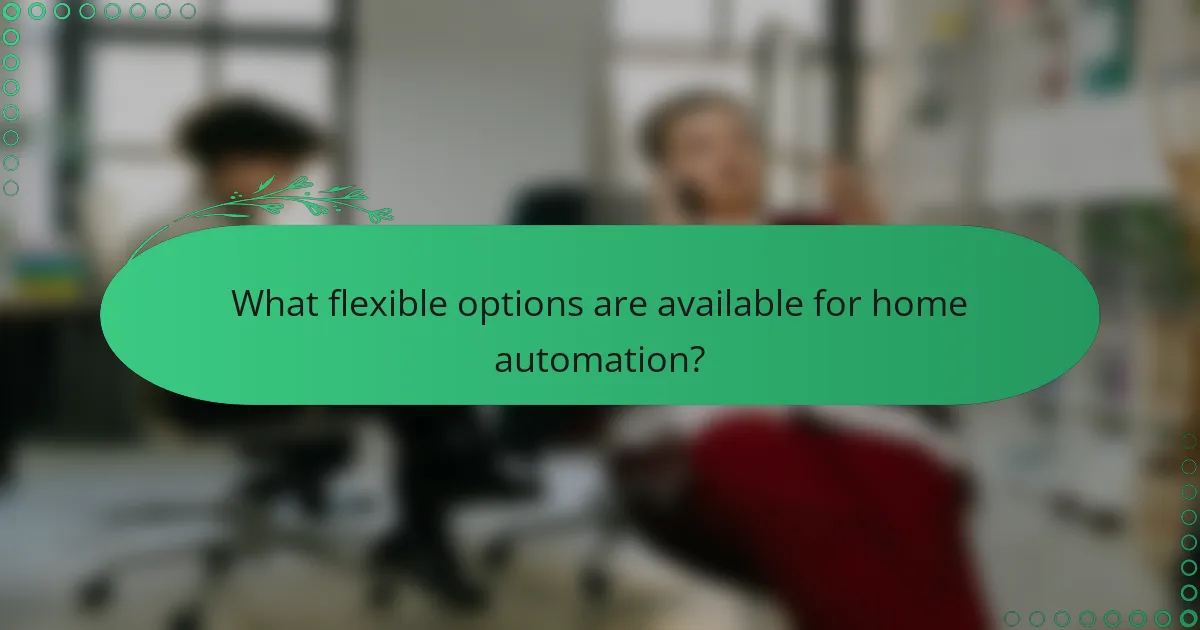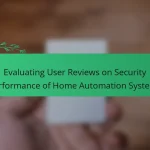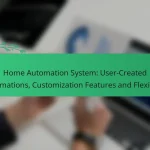Home automation systems are designed to meet unique needs, providing tailored solutions that enhance everyday living. With features like voice control and custom routines, users can create personalized environments that align with their lifestyles. Additionally, the flexibility in setup options ensures that everyone can find a system that fits their preferences and requirements.

What are the best home automation systems for unique needs?
The best home automation systems cater to specific requirements, offering tailored solutions for various lifestyles. Key options include voice control, smart displays, comprehensive integration, and energy efficiency, allowing users to customize their home environment effectively.
Amazon Echo Plus for voice control
The Amazon Echo Plus is an excellent choice for those seeking voice control in their home automation system. With Alexa built-in, users can easily manage compatible smart devices using simple voice commands.
Consider the range of devices that work with Echo Plus, including lights, thermostats, and security systems. This versatility allows for seamless integration, making it a practical option for enhancing convenience and accessibility.
Google Nest Hub for smart displays
The Google Nest Hub serves as a smart display that combines voice control with visual feedback. Users can view information, control devices, and access media all from a single screen, making it ideal for kitchens or living rooms.
This device supports a wide range of smart home products, allowing for easy management of routines and scenes. Its integration with Google Assistant ensures that users can quickly access information and control their environment efficiently.
Samsung SmartThings for comprehensive integration
Samsung SmartThings offers a comprehensive platform for integrating various smart devices into one cohesive system. This hub supports a wide array of products from different manufacturers, making it a flexible choice for users with diverse needs.
SmartThings allows users to create custom scenes and routines, automating multiple devices based on specific triggers. This capability enhances the overall home automation experience, enabling tailored solutions for different situations.
Apple HomeKit for iOS users
Apple HomeKit is designed specifically for iOS users, providing a secure and user-friendly platform for managing smart home devices. With HomeKit, users can control compatible devices through the Home app or Siri, ensuring a seamless experience across Apple devices.
HomeKit’s focus on privacy and security is a significant advantage, as it uses end-to-end encryption. This makes it a reliable choice for users concerned about data protection while enjoying the benefits of home automation.
Ecobee SmartThermostat for energy efficiency
The Ecobee SmartThermostat is a top choice for those prioritizing energy efficiency in their home automation system. This device learns user preferences and adjusts heating and cooling accordingly, potentially reducing energy bills significantly.
With features like remote sensors and integration with various smart home platforms, Ecobee allows users to optimize their home environment for comfort and efficiency. Consider setting up schedules or using geofencing to enhance energy savings further.

How to create custom scenes and routines in home automation?
Creating custom scenes and routines in home automation allows you to tailor your smart devices to fit your lifestyle. This process typically involves selecting specific actions for your devices to perform at designated times or in response to certain triggers.
Using Amazon Alexa routines
To create routines with Amazon Alexa, open the Alexa app and navigate to the “Routines” section. You can set a routine to trigger with a voice command, at a specific time, or based on device status. For example, saying “Goodnight” could turn off lights, lock doors, and adjust the thermostat.
Consider using the “Add Action” feature to include multiple device controls in one routine. Common actions include playing music, adjusting lights, or providing weather updates. Remember to test your routine to ensure everything works as intended.
Setting up Google Assistant scenes
Google Assistant allows you to create scenes through the Google Home app. Start by selecting “Routines” and then tap “Manage routines” to customize actions. You can set triggers based on voice commands or specific times, such as “Start my day” to turn on lights and start your coffee maker.
Utilize the “Add Action” option to include various smart devices in your scene. Keep in mind that some devices may require specific integrations, so check compatibility before setting up your scene.
Creating Apple HomeKit automations
Apple HomeKit automations can be created using the Home app on your iOS device. Tap the “Automation” tab to set triggers based on time, location, or device status. For instance, you can automate your lights to turn on when you arrive home.
When setting up automations, ensure your devices are HomeKit-compatible. You can also create scenes that group multiple actions together, like “Movie Night,” which dims the lights and turns on the TV. Regularly review your automations to optimize performance and adjust as your needs change.

What flexible options are available for home automation?
Home automation systems offer a variety of flexible options to suit different needs and preferences. These options include wireless or wired setups, subscription-based or one-time purchase models, and choices between DIY or professional installation.
Wireless vs. wired systems
Wireless home automation systems use Wi-Fi or other wireless protocols to connect devices, providing ease of installation and flexibility in placement. They are ideal for renters or those who prefer not to deal with extensive wiring.
Wired systems, on the other hand, involve physical connections through cables, which can offer more reliable performance and lower latency. However, they typically require more complex installation and may be better suited for new builds or extensive renovations.
Subscription-based vs. one-time purchase models
Subscription-based models often provide ongoing access to advanced features, updates, and customer support for a monthly fee. This can be beneficial for users who want the latest technology without needing to upgrade hardware frequently.
One-time purchase models involve a single upfront cost for the equipment, which can be more economical in the long run. However, users may miss out on future updates and features unless they invest in new devices later.
DIY vs. professional installation
DIY installation allows homeowners to set up their systems at their own pace, often saving on labor costs. Many modern home automation products are designed for easy installation, making this a viable option for tech-savvy individuals.
Professional installation can ensure that systems are set up correctly and efficiently, which is particularly important for complex setups. This option may come with a higher initial cost but can save time and reduce the risk of errors during installation.

What are the key criteria for selecting a home automation system?
When selecting a home automation system, consider compatibility with existing devices, ease of use and setup, and scalability for future upgrades. These criteria ensure that the system meets your unique needs and can adapt as technology evolves.
Compatibility with existing devices
Compatibility is crucial for a seamless home automation experience. Check if the system supports popular protocols like Zigbee, Z-Wave, or Wi-Fi, which can integrate with various smart devices. For example, if you already own smart bulbs or thermostats, ensure the new system can control them without requiring replacements.
Additionally, look for systems that offer a wide range of supported brands and devices. This flexibility allows you to mix and match products according to your preferences and budget, maximizing your investment in home automation.
Ease of use and setup
An intuitive interface and straightforward setup process are essential for a positive user experience. Choose a system that provides clear instructions and user-friendly apps, allowing you to manage your devices effortlessly. Many systems offer mobile applications that simplify control and monitoring from anywhere.
Consider systems that support voice control through popular assistants like Amazon Alexa or Google Assistant. This feature enhances convenience, enabling you to operate your devices hands-free, which is particularly beneficial for busy households.
Scalability for future upgrades
Scalability ensures that your home automation system can grow with your needs. Look for systems that allow you to easily add new devices or features over time without significant investment. This adaptability is key as new technologies emerge and your requirements change.
Evaluate the manufacturer’s support for updates and new integrations. A system that regularly adds compatibility with new devices or features can provide long-term value, keeping your home automation setup current and functional.

What are the pricing models for home automation systems?
Home automation systems typically follow several pricing models, including upfront costs, subscription fees, and pay-as-you-go options. The choice of model can significantly affect your overall investment and ongoing expenses.
Initial setup costs
Initial setup costs for home automation systems can vary widely based on the complexity of the system and the components you choose. Basic systems may start around a few hundred dollars, while more advanced setups can reach several thousand dollars.
Consider the types of devices you want to integrate, such as smart lights, thermostats, or security cameras, as well as installation fees if you opt for professional help. DIY installations can save money but may require technical know-how.
It’s advisable to budget for additional accessories or upgrades that may enhance your system’s functionality. Always compare prices from different vendors to find the best deals on both hardware and installation services.


